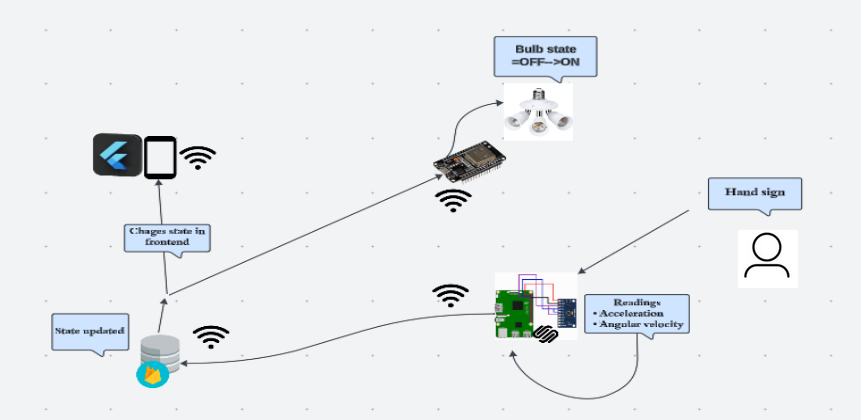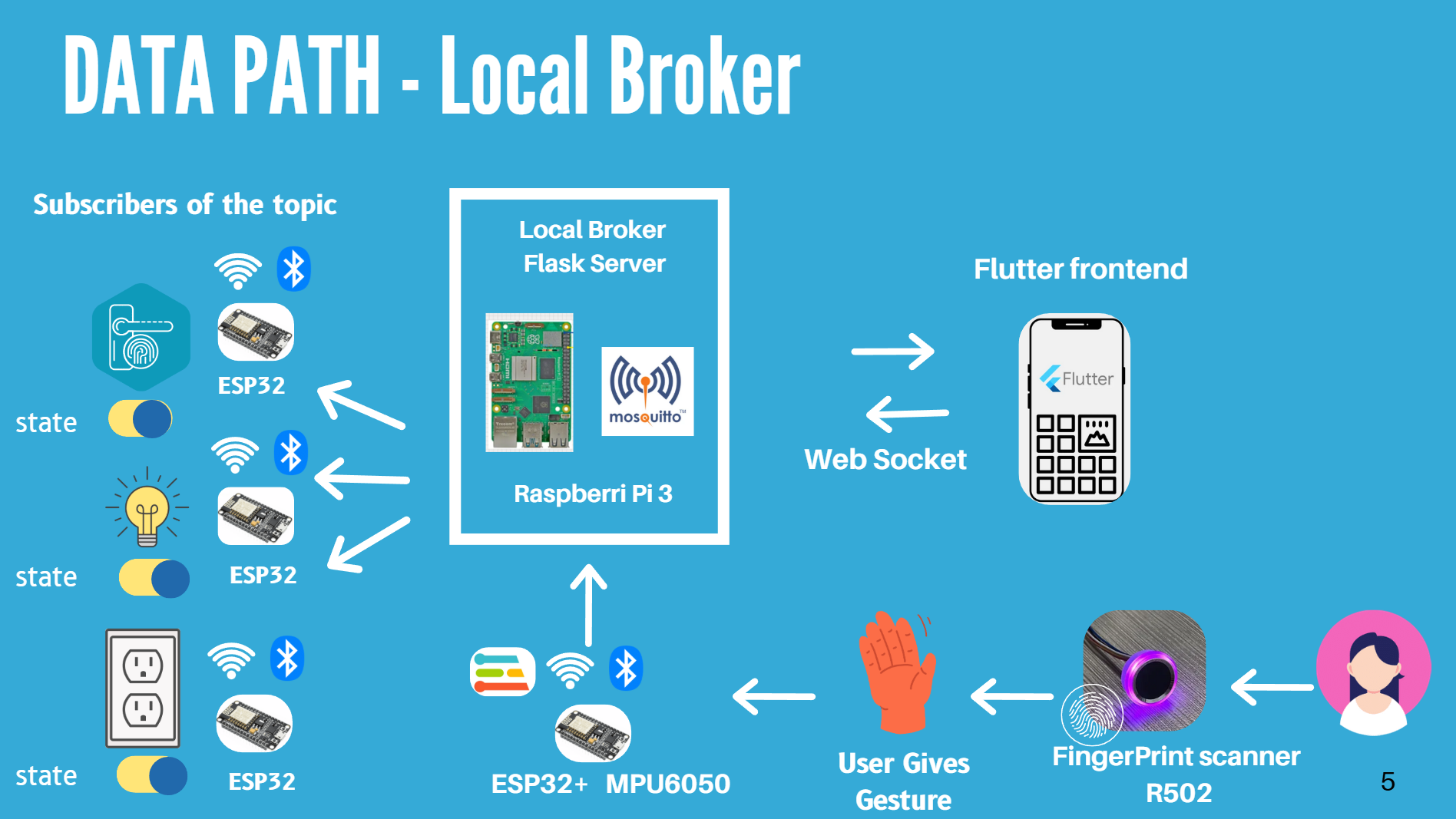Features
Reference
Gesture Recognition
Using wearable-based TinyML gesture recognition, users can control devices with intuitive hand gestures for a seamless, hands-free smart home experience.
System Architecture
Our architecture supports both cloud-based and local communication for enhanced flexibility and reliability:
- ESP32 devices with MPU6050 and fingerprint sensors classify gestures using Edge Impulse TinyML models.
- Classified gestures are published via MQTT to either AWS IoT Core or a Mosquitto broker hosted on a Raspberry Pi 3.
- The Raspberry Pi also runs a Flask server to simulate cloud services for offline operation.
- Smart devices subscribed to MQTT topics respond instantly to gesture commands.
- AWS IoT triggers Lambda functions to update Firebase, while GCP Firebase Functions sync mobile-triggered changes to MQTT.
- The Flutter mobile app reflects real-time device states using Firebase listeners.
System diagrams for both configurations:


Key Features
- Hands-free gesture control via TinyML.
- Local and cloud MQTT fallback communication.
- Fingerprint and gesture-based authentication.
- Real-time updates through Firebase and Flutter app UI.
Hardware Components
| Component | Description |
|---|---|
| ESP32 Dev Module | Processes sensor data, runs the Edge Impulse ML model, and communicates with AWS IoT Core via MQTT. |
| MPU6050 Sensor | Captures precise motion data for gesture recognition. |
| Finger Print Door lock | Enables secure fingerprint-based door unlocking. |
| Smart Sockets & Light Modules | Controlled via ESP32 to automate appliances and lighting based on gesture commands. |
| Fingerprint scanner R502 | Authenticate the user by fingerprint in the wrist band. |
Software Components
| Component | Description |
|---|---|
| Edge Impulse ML Model | Classifies gestures in real-time on the ESP32 microcontroller. |
| MQTT Communication | Enables reliable message delivery between ESP32 and AWS IoT Core. |
| AWS IoT Core | Acts as the central MQTT broker for managing device commands. |
| Firebase | Provides real-time database updates and role-based access control (RBAC). |
| Flutter Mobile App | Displays real-time device status, logs, and gesture configuration settings. |
| GCP Function | Catch the firebase triggers done by mobile app and publish them to IOT core. |
System Workflow
- Gesture is captured and classified by ESP32.
- MQTT message is sent to cloud or local broker.
- Smart device responds to the published command.
- Firebase is updated via Lambda or Flask backend.
- Mobile app updates reflect real-time status from Firebase.
Budget Breakdown
| Item | Quantity | Unit Cost (LKR) | Total (LKR) |
|---|---|---|---|
| Speed Xiao ESP32 Board | 1 | 3,200 | 3,200 |
| esp32 dev module Board | 4 | 2,400 | 9,600 |
| IMU Sensor | 1 | 1,000 | 1,000 |
| R502 Finger Print Sensors | 1 | 6,300 | 6,300 |
| Battery Pack | 1 | 200 | 200 |
| Plug Sockets | 1 | 1,000 | 1,000 |
| Electronic Door Lock | 1 | 2,500 | 2,500 |
| 230V to 5V Converters | 4 | 300 | 1,200 |
| Relays, Triacs, Resistors, etc. | 4 | 300 | 1,200 |
| Wires, Soldering Components | 1 | 3,000 | 3,000 |
| Other Expenses | 1 | 2,000 | 2,000 |
| Flexible 3d print model as Wearable Band | 1 | 1,800 | 1,800 |
| Total | 33,000 | ||
Conclusion
This design ensures a seamless, low-latency, and secure gesture-controlled home automation experience. By integrating ESP32 NodeMCU, fingerprint scanner, smart sockets, and MQTT-based communication, our system enables effortless automation and real-time device control.
Future Developments
- Integration with voice assistants like Alexa and Google Assistant.
- Expansion to support more devices and appliances.
- Enhanced machine learning models for improved gesture recognition accuracy.
Commercialization Plans
- Partnering with smart home device manufacturers for integration.
- Launching a subscription-based service for advanced features.
- Expanding to international markets with localized support.
GitHub Repository
Explore our project on GitHub: FlickNest GitHub Repo